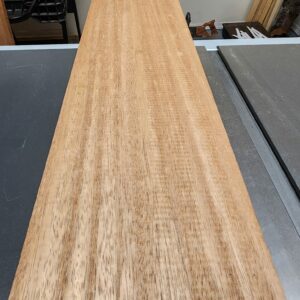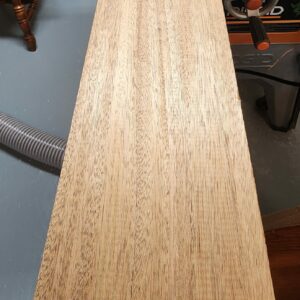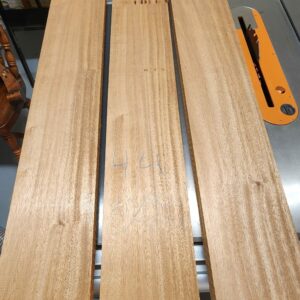Hey all,
I’ve recently decided to make a sjoelbak (a type of shuffleboard) using the plans from van Vliet (https://www.van-vliet.org/dempseywoodworking/sjoelbak.shtml). For the trim, supports, etc. I’ve picked up some african mahogany (I realize there are a couple species called African mahogany, but I’m no botanist unfortunately). Upon doing some more in depth reading, I see that African mahogany CAN be a stress release wood, and can warp considerably AS you’re ripping it, though not always (depends on the stresses inside the board).
Obviously, this could be a significant concern if my nearly 80″ long trim pieces on the sides warp, creating either a crest or valley in the playing board (ignoring the kickback risk if it pinches on the table saw). My plan was initially to rip 2″ strips so those could be used for the 2″ tall rail (and it would be closer to 1″ wide rather than the 3/4″ in the plans provided, but being beefier won’t hurt anything).
Does anybody have any experience with African mahogany, and if so do you have any recommendations for me to minimize the chance of any warping? I’ve attached photos of the boards I have, I figure the grain is likely an indication of if / how bad it may warp, even if only very minor. The boards are approx. 6″ wide, so I could go to just shy of 3″ wide rips, and have a taller rail/trim on the edges of the board if that seems to be the best option, though I’d prefer to stick to the 2″.
I have had the boards acclimating for about 1.5 weeks, I plan to wait 2 weeks minimum, closer to a month or 2 if I have the patience. Where I’m located it’s fairly dry year round and there isn’t much humidity difference in town, I’ve never noticed any wood movement inside even right in wood directly from the lumber store.
Thanks in advance for any input!

















Replies
This wood is no different than other spieces of wood, some will wrap some not, acclimatation wont change anything.
If it's dry, work it. As gulfstar said, it will do now whatever it will do later.
I've used it a bunch, and had zero issues. It can be a pain to handplane, because the grain keeps changing direction. But I enjoy working with it.
Look at the ends of the boards and try to make the parts where flat is critical from quartered or rifty grain, avoiding areas of flatsawn wood.
After that there's nothing to it but to do it.
Sounds good, will just cut my strips and see what happens thanks.
When I need straight pieces, I rip blanks about 1/4" to 3/8" wider than what I need with my bandsaw. I always do this with cherry and other woods prone to bow. (This includes framing 2x lumber as well.) Then I joint one edge and rip a small amount off the other edge that generally doesn't affect the straightness. Ripping wood with internal stresses on the table saw is an invitation for a dangerous kickback. No chance of kickback with the bandsaw.